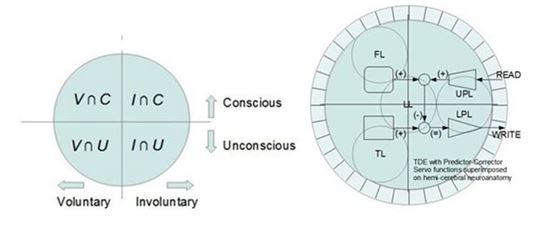Cybercognition - Cybernetic Computational Cognition Theory -© 2014
.
.
The Cybernetic-Computational Engine - an intelligent agent with internal experience
by Charles Dyer BE (Mech.) BSc (Hons). Copyright © October 2014
Tricyclic Differential Engine
by Charles Dyer BE (Mech.) BSc (Hons). Copyright © October 2014
Tricyclic Differential Engine
The TDE is the first subjective model of the human brain and mind. Its author/inventor is Charles Dyer, from Flinders University[1], in South Australia. The TDE is a model of brain and mind intended for use in medical science, eg to develop better psychological (cognitive-behavioural) and psychiatric (psychopharmaceutical) therapies. It represents a 'game-changing' advance in cognitive modelling because it treats phenomenology (ie experiential effects) in a rigorous, quantitative way. The basic sub-sections of the vertebrate brain (temporal, frontal, limbic, parietal lobes and paleocerebellum) map naturally to the TDE's distinct set of information processing functions, in a way that has never been achieved with existing approaches.

The development of the TDE began with constructing dichotomous divisions of sensory and motor channels into Conscious/ Subconscious and Voluntary/ Involuntary (left figure). Next, these dichotomous pairs were themselves paired into a four-state machine, which cycled between four compound experiential states, {C^V, C^I, S^I, S^V}. Each experiential compound state corresponds to a commonly understood state of mind. That is, this 4-machine is an intuitively correct one.
The TDE 4-state diagram maps rather neatly onto two simultaneous functional schemata (right diagram) -
1. a map of the information flows in each cerebral hemisphere
2. a cybercircuit (servo loop with state) as per cybernetic system state depiction.
1. a map of the information flows in each cerebral hemisphere
2. a cybercircuit (servo loop with state) as per cybernetic system state depiction.